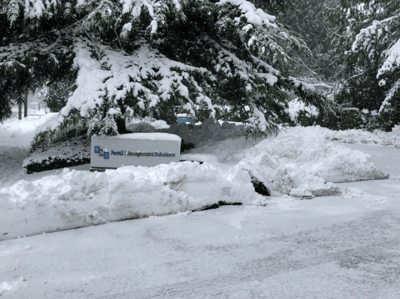 This past weekend, northwest Washington showed just how much the groundhog’s 2019 prediction for an early spring mattered. As Friday afternoon rolled around, the snow started falling. And it kept falling, pretty much all weekend long and late into Monday afternoon.
This past weekend, northwest Washington showed just how much the groundhog’s 2019 prediction for an early spring mattered. As Friday afternoon rolled around, the snow started falling. And it kept falling, pretty much all weekend long and late into Monday afternoon.
In the days leading up to our little winter storm, everyone was preparing for the worst case scenario-fearing days without being able to leave the house, potential power outages and who knew what else. Grocery stores were packed and it wasn’t long before many began to run out of basics like bread, milk and eggs.
At the same time as I was watching newscasts showing panicked people rushing around to prepare for the storm, I got to experience a sharp contrast at RMS as emergency plans were calmly reviewed and put into action. With customers in every state across the country, the show must go on no matter what is going in our little corner of the world. So we checked the generators, tested battery backups, and made sure that every main office employee could still work and help customers just like normal. The ease with which we achieved business as usual in a less than ideal scenario served as a great reminder for how far a little preparation can take you.
If you don’t have an emergency plan in place for disasters (weather or otherwise) here are a few helpful hints for your pharmacy.
- Make sure all of your computers are on functioning battery backups. A good battery backup should give you about 10 minutes of continued use when the power goes down. However, this doesn’t mean that you should keep ringing transactions until the screen goes black. The battery backup should allow you to finish whatever transaction you are working on and then use the proper steps to safely shut down your PC. This will help you to avoid power surges that could damage your system.
- Know where the keys to your cash drawers are. Most cash drawers are receipt printer driven, so if the power goes out, you’ll have no way to open the cash drawer without the keys. Double check to make sure you have working keys to all of your cash drawers so that they can be manually opened as needed.
- Call your credit card processor to discuss emergency processing options. Your processor can provide you with phone numbers for each network’s voice authorization so that you can verify credit card transactions. This way, if the internet or power fails, you still have an option to process credit cards.
- Invest in some basic transaction supplies. Solar or battery powered calculators, paper signature logs, and receipt books are a must for when the power goes out. It may seem old fashioned but it may very well be the only way you’ll have to document sales and help clerks to stay accurate and accountable. When the power comes back on, you’ll be able to run all of these transactions through the POS to keep inventory and cash balancing accurate. You may also want to consider assigning each clerk with a specific drawer to work out of in case of shortages.
- Stock up on emergency supplies. Expecting the unexpected can help to keep your staff and customers safe. Having some solar or battery powered lanterns to light the store if the lights go out can at a minimum help customers to safely navigate out of the store.
- Run daily backups of your point-of-sale system. No matter how well you prepare, sometimes severe weather gets the best of your computers. Getting back to normal after a power outage is just as important as being there to help your customers during the outage. However, you won’t be able to do this if you don’t have a good backup to help you recover from a system failure. The good news is backups are crazy-easy to set up. Just get a couple of USB flash drives, and then contact RMS to have the automated backup set to run each night. Every day before you leave the store, swap the drives and take yesterday’s backup with you or place it in a fireproof/waterproof safe.
- Help your employees plan to get to work safely. If you’re going to keep your pharmacy open during severe weather, you’ll need to plan for staff to get into work safely. Plan on who can safely travel to the pharmacy in tough conditions so you know who you’re go-to employees will be.
As the snow is finally thawing here, one last lesson learned is to always be reviewing your contingency plans. This planning will pay off the next time you have to navigate tricky weather situations or unexpected service outages in your pharmacy.